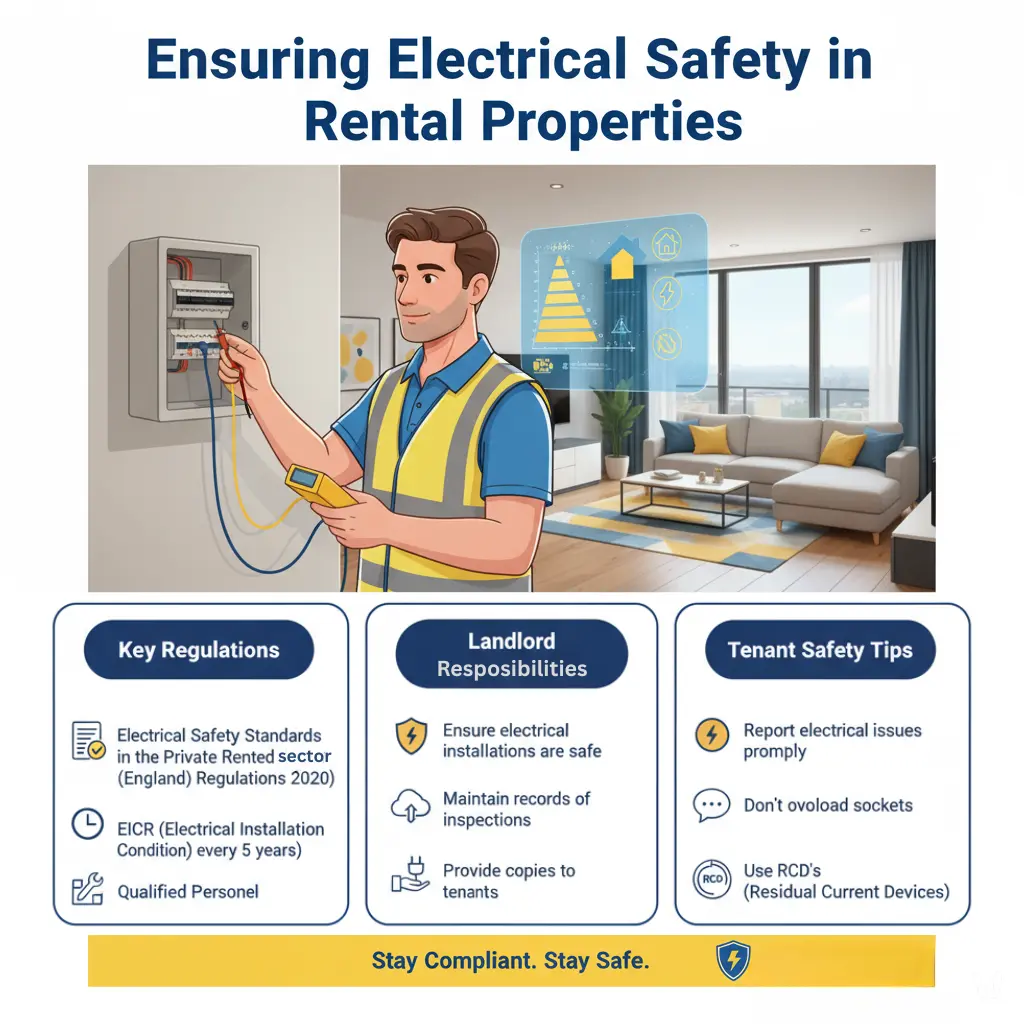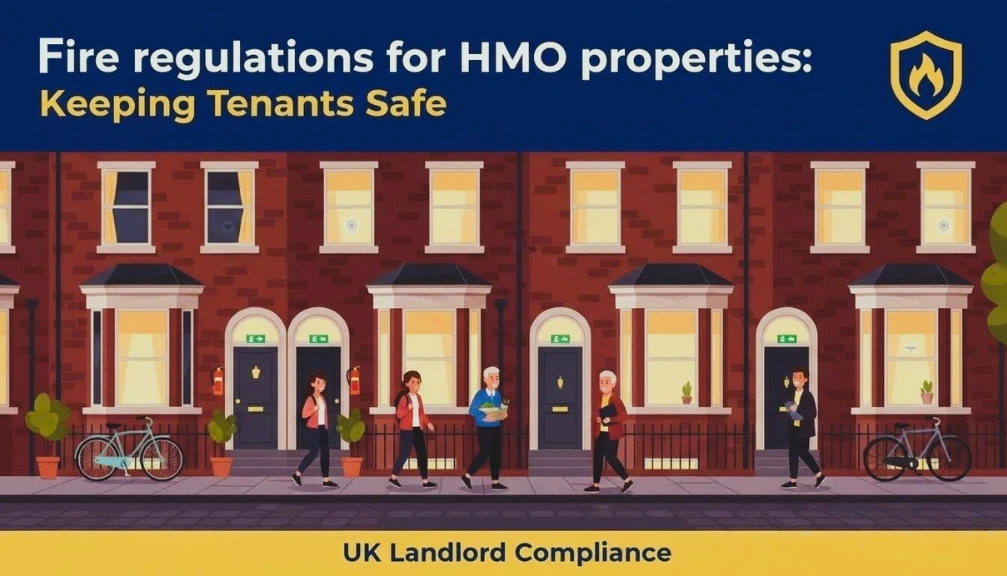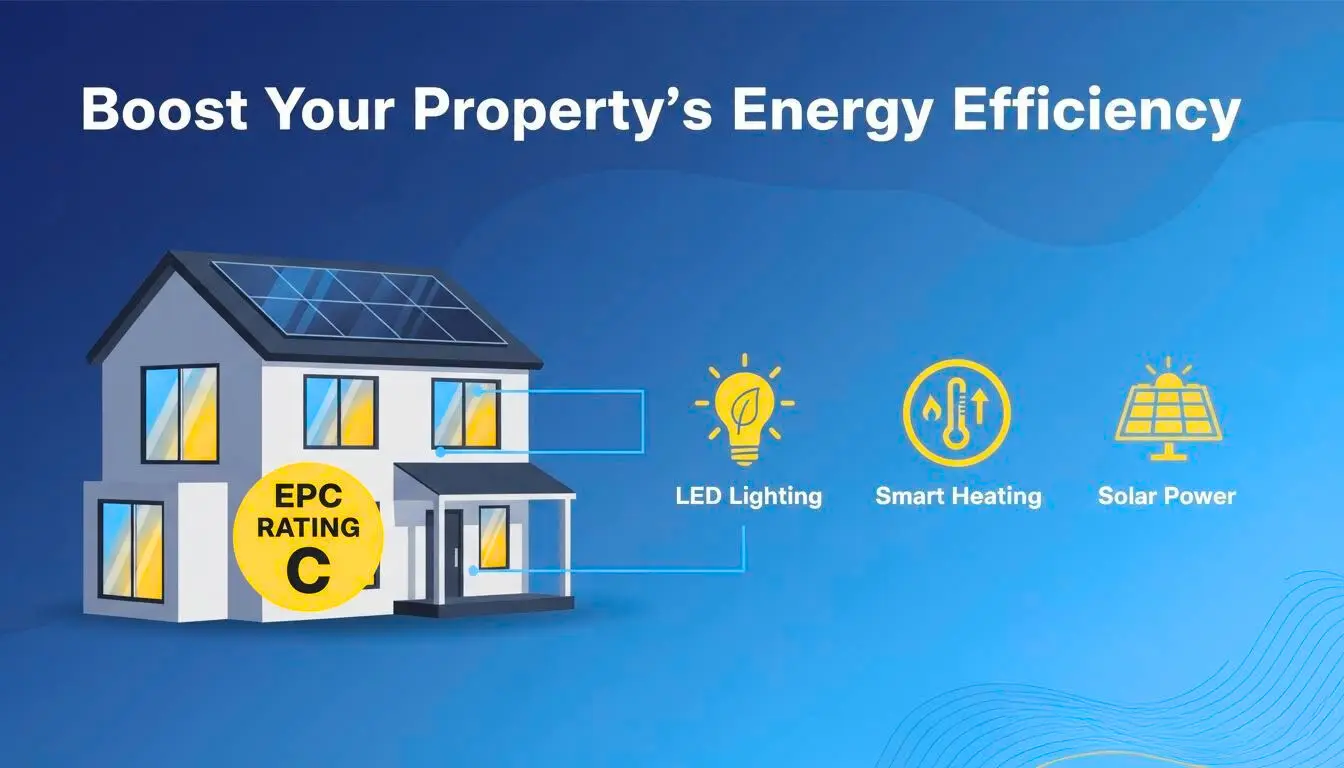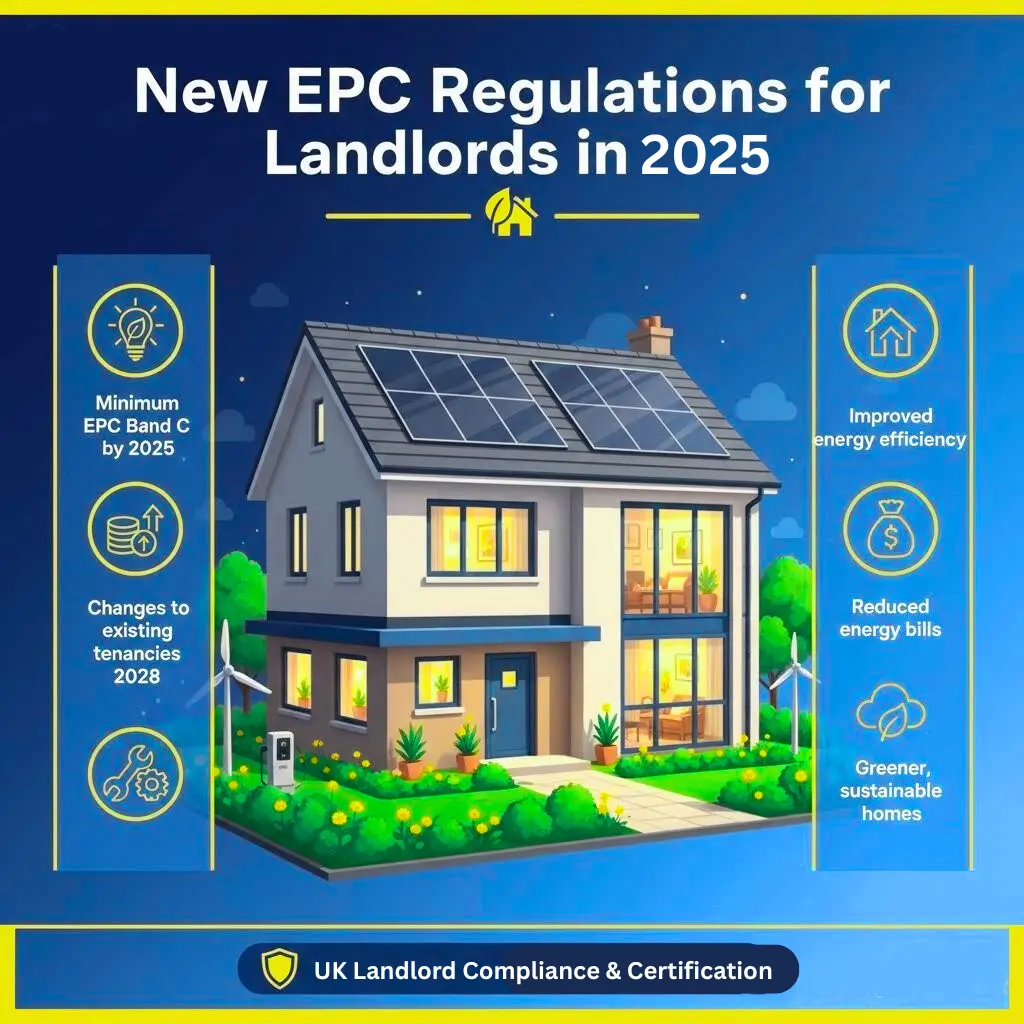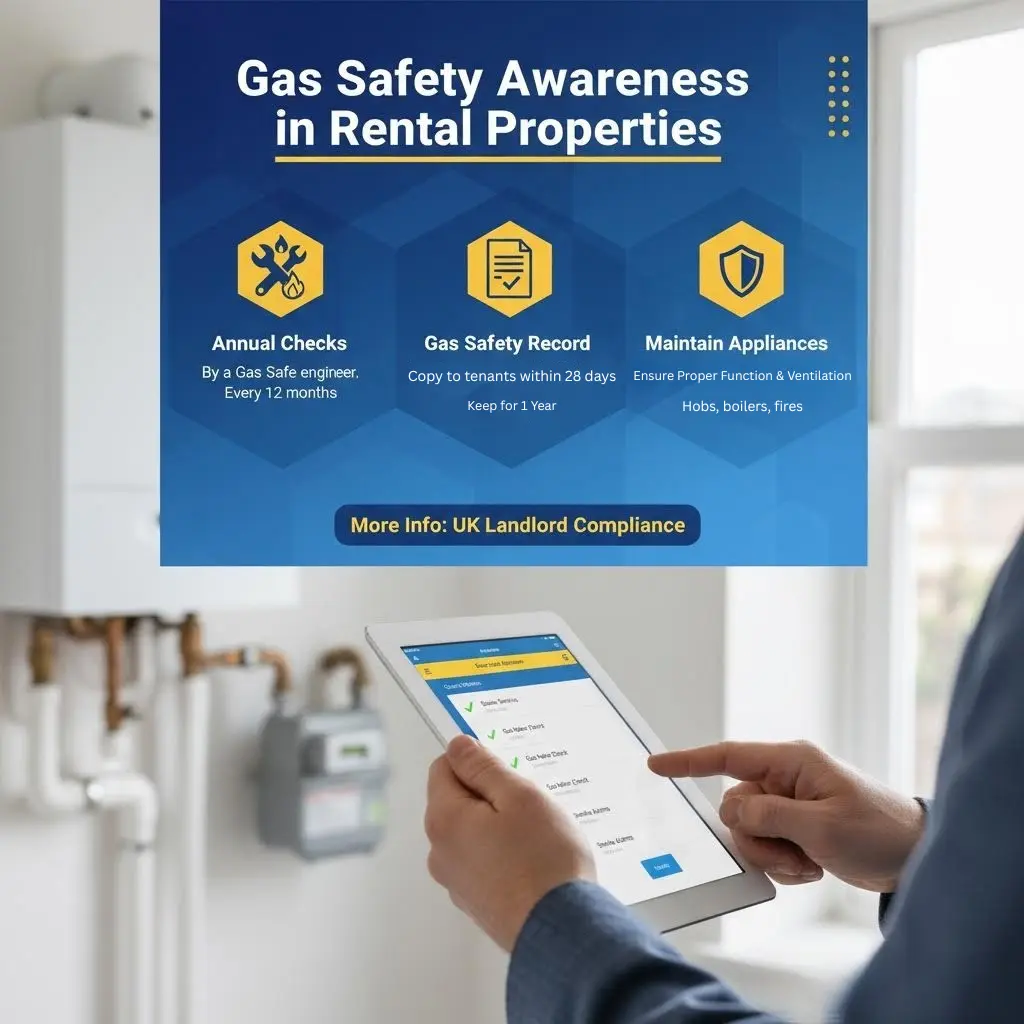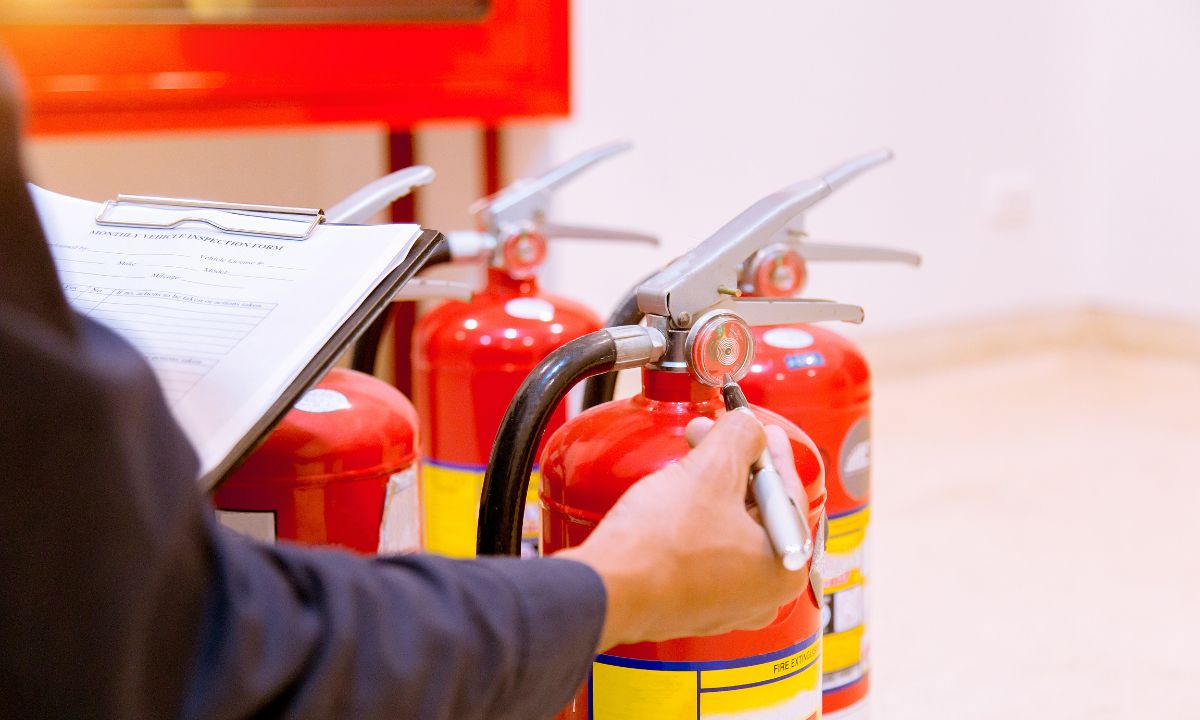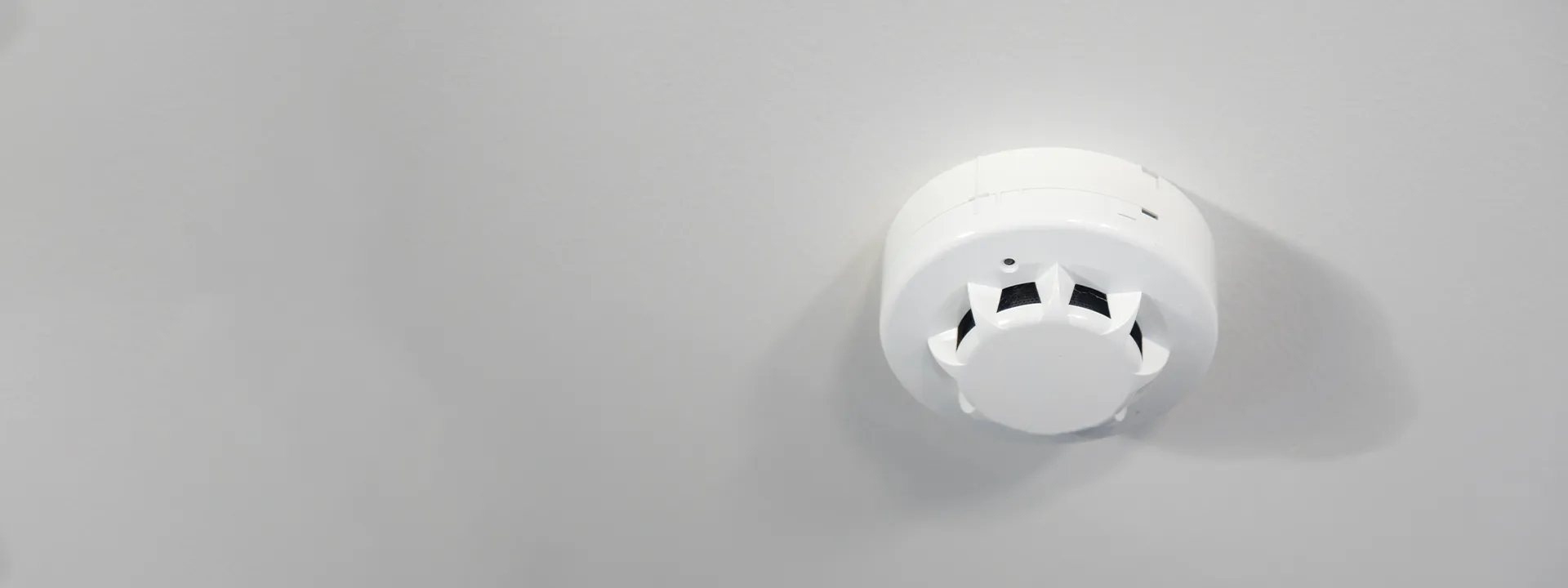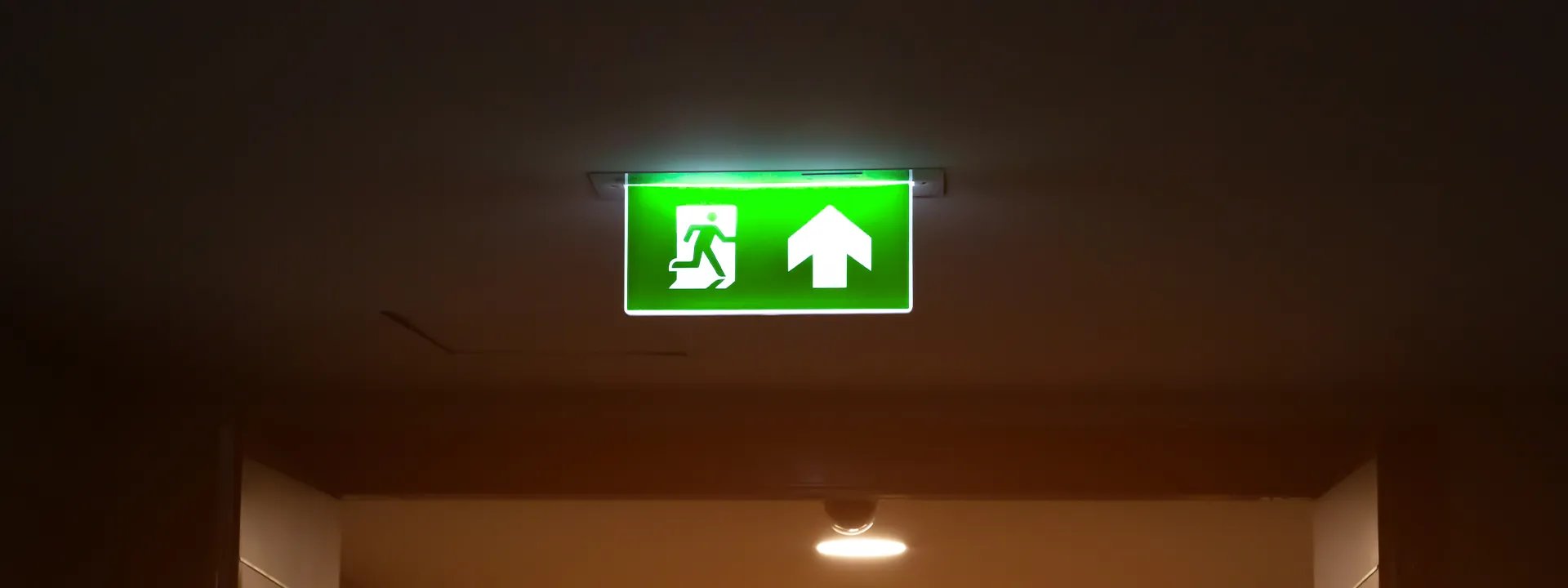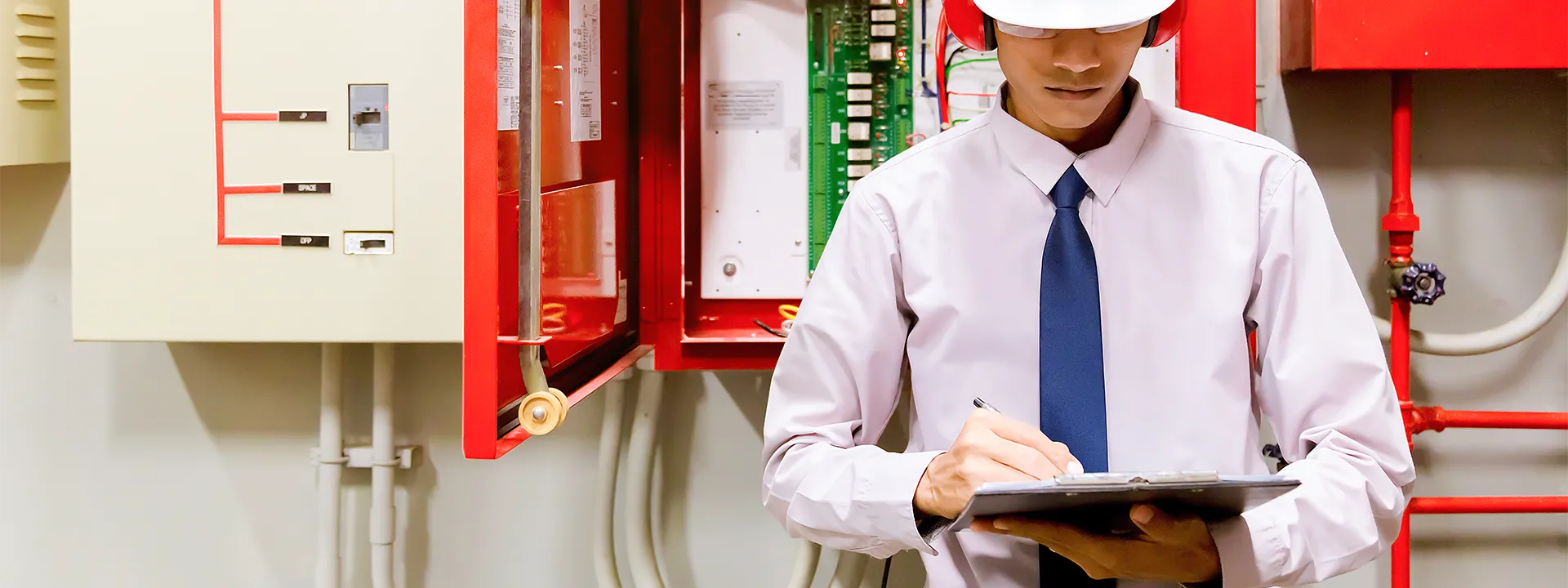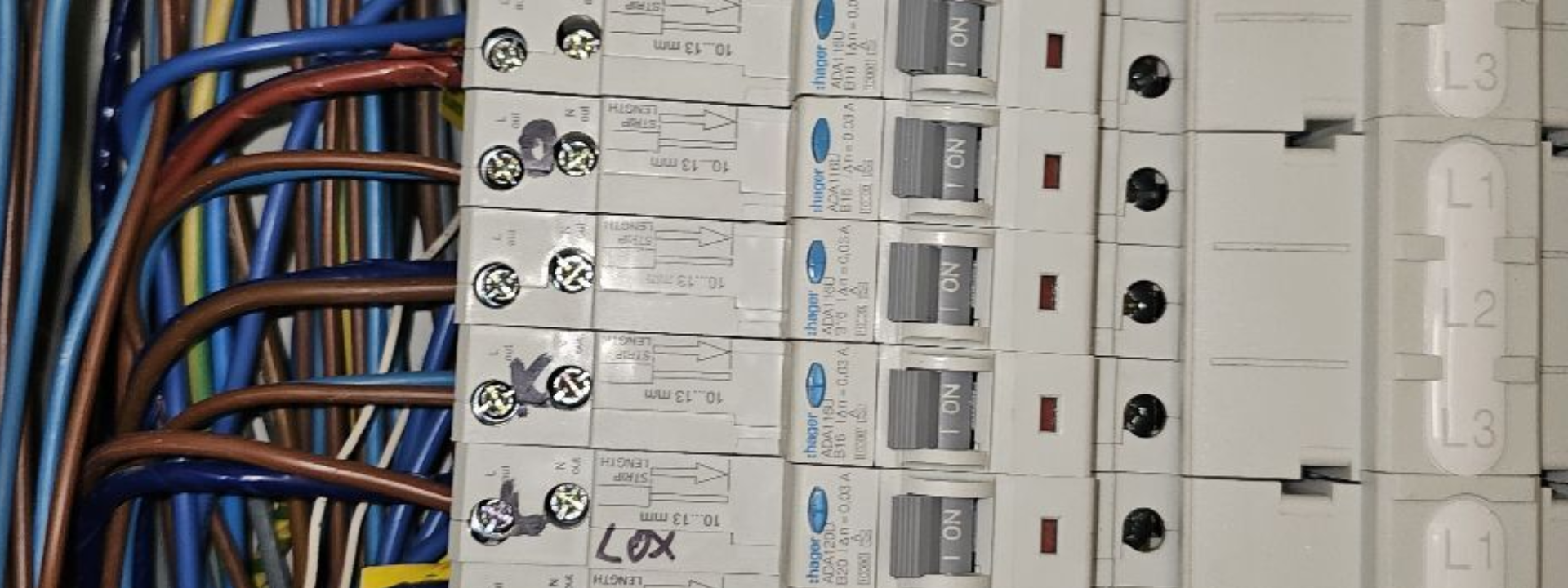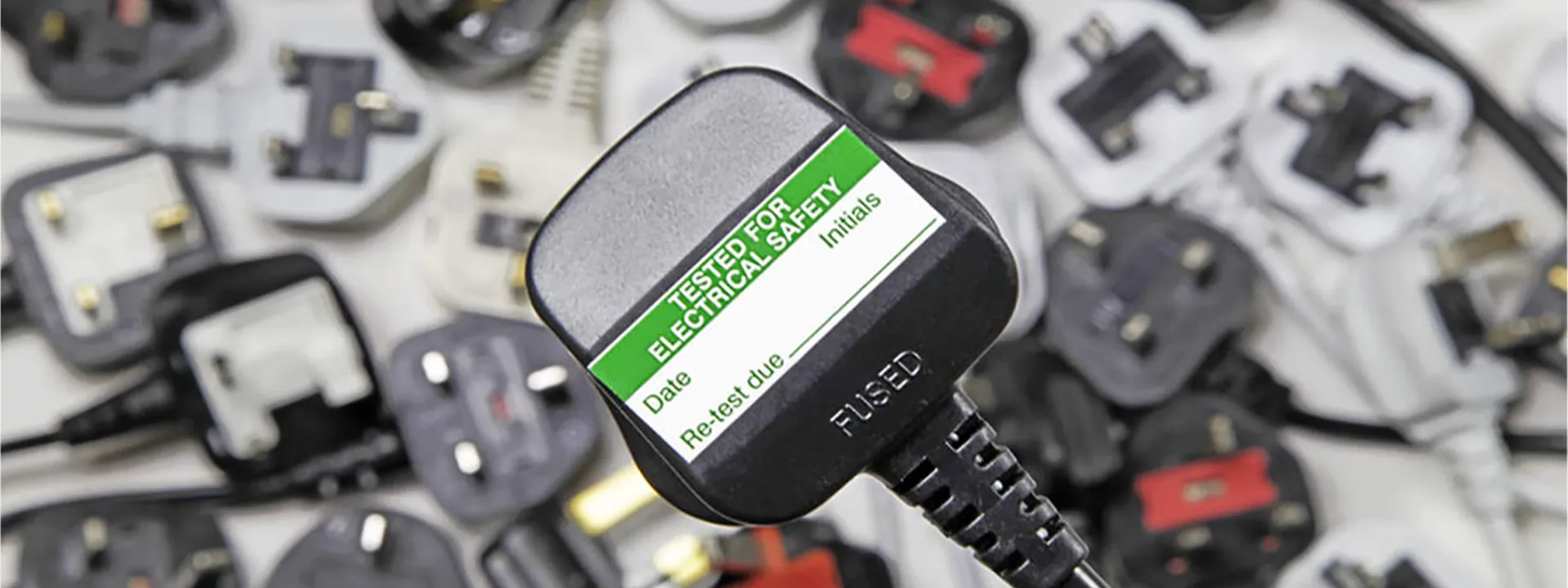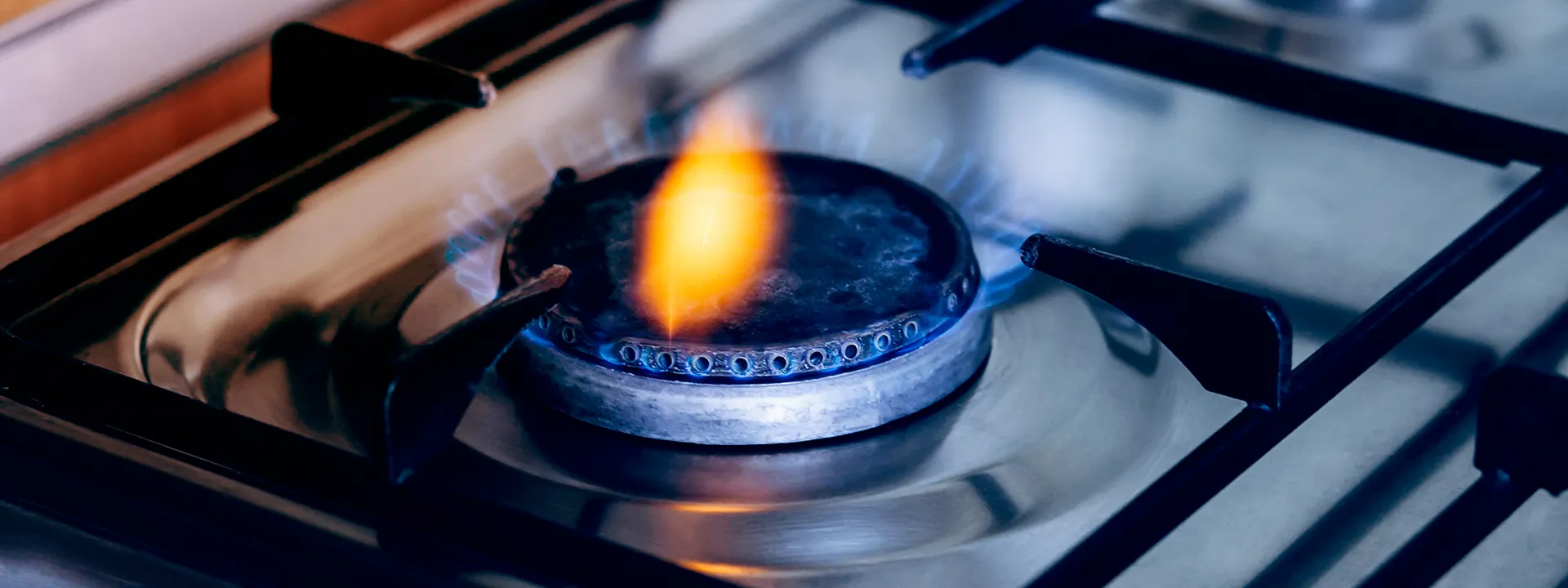Keeping rental properties safe is one of the most important responsibilities for landlords. Electrical safety is a key part of this. In 2018‑19, there were 14,186 accidental domestic fires of electrical origin in England, making up 53.4 % of all accidental dwelling fires. Over half of all accidental dwelling fires. More than 71 % of electrical fires in 2017‑18 were started by appliances. Faulty wiring and appliances cause many of these fires, so ensuring your property is safe is essential.
Landlords need to perform electrical safety checks to ensure that rental properties are safe for tenants. Landlords must give tenants a copy of the inspection report and also send one to the local council.
This guide shows landlords exactly what they need to do to keep rental homes safe. From understanding inspections and reports to fixing problems and keeping records, it explains everything in simple terms that are easy to follow. Let’s dive into this.
What are the electrical safety requirements for landlords in 2025?
Landlords in England must ensure all wiring, sockets, and electrical appliances in rental properties are safe for tenants. This applies to private rented homes, HMOs, assured short-term tenancies, and properties with licenses to rent. Every property needs an electrical installation condition report (EICR) done by a qualified and competent person.
Landlords must carry out electrical safety checks for landlords at least every five years. If any problems appear, landlords take remedial action quickly and provide written confirmation when the work is done. Landlords give a copy of the EICR to the tenant and send a copy to the local housing authority within 28 days.
The latest electrical regulations for rental properties
Landlords need to understand the key rules and steps to keep their rental properties electrically safe. The main requirements are:
![]() Landlords must follow rules from the Electrical Safety Standards in the Private Rented Sector (England) Regulations 2020.
Landlords must follow rules from the Electrical Safety Standards in the Private Rented Sector (England) Regulations 2020.![]() Rules apply to private tenancies, includes assured shorthold tenancies, houses in multiple occupation (HMOs), lodgers, and properties with licences to occupy.
Rules apply to private tenancies, includes assured shorthold tenancies, houses in multiple occupation (HMOs), lodgers, and properties with licences to occupy.![]() All electrical installations must be inspected and tested by a qualified person and a competent person.
All electrical installations must be inspected and tested by a qualified person and a competent person.![]() Inspections cover wiring, sockets, switches, and electrical appliances provided.
Inspections cover wiring, sockets, switches, and electrical appliances provided.![]() Landlords receive an electrical installation condition report (EICR) showing if the property is safe for continued use.
Landlords receive an electrical installation condition report (EICR) showing if the property is safe for continued use.![]() The EICR highlights any remedial or further investigative work needed.
The EICR highlights any remedial or further investigative work needed.![]() Landlords must carry out electrical safety checks for landlords at least every five years.
Landlords must carry out electrical safety checks for landlords at least every five years.![]() Any electrical issues must be fixed within 28 days of the inspection.
Any electrical issues must be fixed within 28 days of the inspection.![]() Landlords provide a copy of the EICR to the tenant before the tenancy starts.
Landlords provide a copy of the EICR to the tenant before the tenancy starts.![]() A copy of the EICR must be sent to the local housing authority within 28 days.
A copy of the EICR must be sent to the local housing authority within 28 days.![]() The rules apply to existing tenancies and new tenancies from April 2025.
The rules apply to existing tenancies and new tenancies from April 2025.![]() Portable appliances provided by the landlord must be checked and kept in proper working order.
Portable appliances provided by the landlord must be checked and kept in proper working order.
Key changes to electrical safety legislation for 2025
The new rules for 2025 ensure rental homes are safe in London. Landlords must focus on:
![]() Regular inspections of all rental properties, including existing tenancies and new tenancies from April 2025.
Regular inspections of all rental properties, including existing tenancies and new tenancies from April 2025.![]() Fixing any electrical faults within 28 days of the inspection.
Fixing any electrical faults within 28 days of the inspection.![]() Reporting results to tenants and local authorities promptly.
Reporting results to tenants and local authorities promptly.![]() Ensuring appliances and wiring are in proper working order.
Ensuring appliances and wiring are in proper working order.
Penalties for non-compliance with electrical safety checks
A landlord in Hastings was fined £10,000 for not providing a valid electrical safety certificate. If landlords do not follow electrical safety properly, they face:
![]() Local authorities can serve a remedial notice, requiring landlords to carry out remedial work, if a landlord breaks the Electrical Safety Standards in the Private Rented Sector (England) Regulations 2020.
Local authorities can serve a remedial notice, requiring landlords to carry out remedial work, if a landlord breaks the Electrical Safety Standards in the Private Rented Sector (England) Regulations 2020.![]() If the landlord does not act, the council can fix the problem and recover the cost.
If the landlord does not act, the council can fix the problem and recover the cost.![]() Landlords can be fined up to £30,000 for breaking the rules.
Landlords can be fined up to £30,000 for breaking the rules.![]() Some councils start with lower fines (£12,500 or £17,500) but raise them for aggravating factors, like using an unqualified person.
Some councils start with lower fines (£12,500 or £17,500) but raise them for aggravating factors, like using an unqualified person.![]() Non-compliance can affect insurance, cause civil liability, or lead to criminal charges.
Non-compliance can affect insurance, cause civil liability, or lead to criminal charges.
How often do landlords need to conduct electrical safety checks?
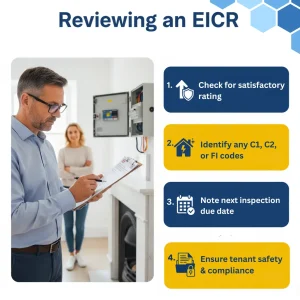
Under UK law, landlords must ensure that privately rented homes are safe for tenants. Electrical checks for landlords are a legal duty, which includes:
![]() Do electrical checks regularly.
Do electrical checks regularly.![]() Carry out a periodic inspection at least every 5 years.
Carry out a periodic inspection at least every 5 years.![]() Ensure all systems follow electrical safety regulations.
Ensure all systems follow electrical safety regulations.![]() Perform portable appliance testing if needed.
Perform portable appliance testing if needed.
Frequency requirements for electrical safety certificates
After an inspection, landlords are required to get an electrical installation certificate or an electrical safety certificate. These certificates prove that the property’s electrical systems have been properly inspected and tested. Electrical safety rules apply to all private rental homes. Electrical safety regulations apply to all privately rented homes.
In the UK, the key standard is BS 7671:2018 (IET Wiring Regulations). As a landlord, keep records of electrical safety inspections and update them when a new tenant moves in. The Housing Act 2004 ensures all private rental homes follow these safety rules to protect tenants.
When additional electrical checks might be necessary
Every five years, the property gets an inspection. But landlords do extra checks if there is a problem or change in the property.![]() After big renovations or changes to the electrical system.
After big renovations or changes to the electrical system.![]() If a private tenant notices issues with electricity.
If a private tenant notices issues with electricity.![]() When portable appliance testing shows a possible risk.
When portable appliance testing shows a possible risk.![]() If the lease is long, such as a lease of 7 years.
If the lease is long, such as a lease of 7 years.
These extra checks keep the property safe, follow electrical safety rules, and protect tenants from harm.
Record-keeping requirements for electrical safety documentation
Landlords keep a copy of the electrical safety report or certificate for every inspection. This documentation must be provided to tenants and, in some cases, to the local authority within 28 days of completion. Records include:![]() Keep records of all electrical inspections and tests.
Keep records of all electrical inspections and tests.![]() Document any maintenance or repairs done on electrical systems.
Document any maintenance or repairs done on electrical systems.![]() Record accidents, faults, or near misses involving electricity.
Record accidents, faults, or near misses involving electricity.![]() Maintain training and certification records for staff working with electricity.
Maintain training and certification records for staff working with electricity.![]() Include date, person responsible, equipment details, findings, and actions taken.
Include date, person responsible, equipment details, findings, and actions taken.![]() Store records safely and make them easy to access.
Store records safely and make them easy to access.![]() Keep records for the legally required period.
Keep records for the legally required period.
Landlords ensure that all information about the property’s electrical safety is clear. This helps keep the home safe and follow the rules.
What does an electrical safety check for rental properties involve?

According to UK regulations, landlords are required to have the electrical systems in their properties inspected and tested regularly. These checks involve examining all wiring, sockets, switches, and fixed appliances to detect any faults or hazards. Landlords may also need to ensure:![]() Portable appliances are safe
Portable appliances are safe![]() Any outdated electrical installations are upgraded
Any outdated electrical installations are upgraded
Get Your Free Electrical Safety Checklist
Keep Your Property Compliant and Protect Your Tenants From Electrical Hazards.
Download the guide and make Electrical Safety Checks simple, clear, and hassle-free.
Components of a comprehensive Electrical Installation Condition Report (EICR)
A thorough EICR covers multiple areas of the electrical system, including:![]() Inspection of wiring and circuits for wear or damage.
Inspection of wiring and circuits for wear or damage.![]() Testing of consumer units and circuit breakers.
Testing of consumer units and circuit breakers.![]() Checking sockets, light fittings, and switches for safety.
Checking sockets, light fittings, and switches for safety.![]() Assessing earthing and bonding to prevent electric shocks.
Assessing earthing and bonding to prevent electric shocks.![]() Providing remedial recommendations if any faults are found.
Providing remedial recommendations if any faults are found.
Landlords must ensure that electrical installations are safe and meet the standards set by regulations.
What electrical inspectors look for during a rental property assessment
During an assessment, inspectors focus on identifying potential risks such as:![]() Overloaded circuits
Overloaded circuits![]() Improperly installed or deteriorated wiring
Improperly installed or deteriorated wiring![]() Faulty or missing earthing
Faulty or missing earthing![]() Damaged sockets or switches
Damaged sockets or switches![]() Signs of moisture or fire hazards around electrical installations
Signs of moisture or fire hazards around electrical installations
To comply with electrical safety first guidelines, landlords should find an electrician from a trusted and experienced company like alllandlordcertificates.co.uk.They know who is qualified and registered to do the inspections.
How long does an electrical safety check typically take
In the UK, landlord electrical safety checks are legally required for rental properties. So, the duration of an electrical safety check depends on the size and complexity of the property:![]() One-bedroom or small flat: Around 1–2 hours.
One-bedroom or small flat: Around 1–2 hours.![]() Two to three-bedroom house: Approximately 2–4 hours.
Two to three-bedroom house: Approximately 2–4 hours.![]() Larger properties or properties with extensive electrical systems: Could take 4–6 hours or more.
Larger properties or properties with extensive electrical systems: Could take 4–6 hours or more.
The time can change depending on the age of the property, how many circuits there are, how easy it is to reach the wiring, and any electrical problems that need a closer look.
What happens if issues are found during an electrical safety check?
During an electrical safety test landlord arranges, the inspector will check the home carefully to find any issues. Some problems are small, like a loose plug or a broken switch, and they can be fixed quickly. Other issues are serious, like damaged wires or overloaded circuits, and they require a professional to repair them properly.
After the inspection, the landlord receives a landlord electrical safety certificate. This certificate shows which parts of the home are safe and which need repair. Fixing these problems keeps everyone safe and helps prevent accidents, shocks, or fires. Following the certificate ensures the home stays safe and the electrical system works correctly.
Understanding C1, C2, and C3 electrical defect classifications
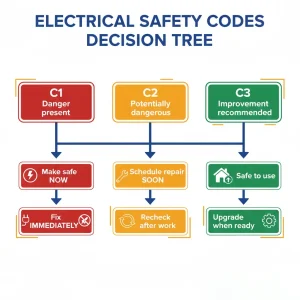
Each electrical check landlord report includes three main codes that show the level of risk:
- C1 – Danger present
This means something is unsafe right now. The electrician will make the issue safe before leaving. Repairs need to happen immediately.Real example: A socket in the kitchen has exposed live wires. The electrician turns off that circuit and replaces the socket straight away. - C2 – Potentially dangerous
The installation is not immediately unsafe but could become risky. The landlord must arrange repairs soon.Real example: The bathroom light fitting has no proper earthing. It still works, but it could cause a shock if not fixed. - C3 – Improvement recommended
The system is safe, but upgrading would make it even safer. Repairs are not required right away.Real example: The property has an old fuse box that works fine, but replacing it with a modern consumer unit would improve protection.
Timeframes for completing remedial electrical works
Here’s what landlords need to know about the timing and process for addressing electrical issues identified in a safety report:![]() If the report shows C1 or C2 issues, landlords must be fix them within 28 days of receiving the report.
If the report shows C1 or C2 issues, landlords must be fix them within 28 days of receiving the report.![]() Some problems may need faster action if the electrician says so. Acting quickly keeps the home safe and follows safety rules.
Some problems may need faster action if the electrician says so. Acting quickly keeps the home safe and follows safety rules.![]() After repairs, the electrician gives written proof that the electrical system is now safe.
After repairs, the electrician gives written proof that the electrical system is now safe.![]() The landlord gives this proof to tenants within 28 days.
The landlord gives this proof to tenants within 28 days.![]() The same confirmation goes to the local council if they ask.
The same confirmation goes to the local council if they ask.![]() C3 issues are not dangerous but show where improvements can be made.
C3 issues are not dangerous but show where improvements can be made.![]() There is no set deadline for C3 items, but upgrading helps keep the property safe.
There is no set deadline for C3 items, but upgrading helps keep the property safe.![]() Fixing problems fast after a check reduces risk and shows that tenant safety comes first.
Fixing problems fast after a check reduces risk and shows that tenant safety comes first.
After the work is done, the electrician provides a written confirmation that everything is safe.
Landlord responsibilities when addressing electrical safety failures
Regulations require landlords to:![]() Arrange regular electrical check landlord inspections by a qualified electrician.
Arrange regular electrical check landlord inspections by a qualified electrician.![]() Fix any C1 or C2 issues within the set time.
Fix any C1 or C2 issues within the set time.![]() Keep records of the landlord electrical safety certificate and all repair reports.
Keep records of the landlord electrical safety certificate and all repair reports.![]() Give tenants a copy of the report within 28 days of receiving it.
Give tenants a copy of the report within 28 days of receiving it.![]() Provide new tenants with the latest electrical report before they move in.
Provide new tenants with the latest electrical report before they move in.
What are the specific electrical requirements for HMOs and different property types?
Electrical safety matters in every property. Electrical safety for landlords is essential to protect tenants. It becomes even more important in Houses in Multiple Occupation (HMOs) and in properties with special or complex electrical setups. Knowing what each type of property needs helps keep people safe, follow the rules, and keep the system reliable for years. UK electrical installations must comply with:
![]() BS 7671 (IET Wiring Regulations): the primary standard for electrical installations
BS 7671 (IET Wiring Regulations): the primary standard for electrical installations![]() Part P of the Building Regulations governs electrical safety in domestic properties.
Part P of the Building Regulations governs electrical safety in domestic properties.
Key points:![]() Circuits must be installed safely with proper RCD protection.
Circuits must be installed safely with proper RCD protection.![]() Sockets, lighting, and fixed appliances must be installed according to their intended use.
Sockets, lighting, and fixed appliances must be installed according to their intended use.![]() Periodic inspections should be done every 10 years for normal domestic properties, or sooner for rental properties.
Periodic inspections should be done every 10 years for normal domestic properties, or sooner for rental properties.
Additional electrical safety standards for Houses in Multiple Occupation (HMOs)
HMOs are homes rented by three or more people who are not from the same household. These tenants share kitchens, bathrooms, and other facilities. Because more people use electricity, HMOs need stronger safety measures:
1. Electrical Safety Standards![]() Electrical Installation Condition Report (EICR):
Electrical Installation Condition Report (EICR):
- Must be carried out at least every 5 years, or at change of tenancy (some local authorities require sooner for HMOs).
- Confirm the system is safe for continued use.
![]() Immediate remedial work must be carried out if any C1 (danger present) or C2 (potentially dangerous) codes are identified.
Immediate remedial work must be carried out if any C1 (danger present) or C2 (potentially dangerous) codes are identified.
2. Minimum Socket and Circuit Requirements![]() Each bedroom must have at least one double socket (sometimes more, depending on size).
Each bedroom must have at least one double socket (sometimes more, depending on size).![]() Separate circuits for high-load areas like kitchens and bathrooms.
Separate circuits for high-load areas like kitchens and bathrooms.![]() Lighting circuits must be adequate, with proper emergency lighting in common areas for larger HMOs.
Lighting circuits must be adequate, with proper emergency lighting in common areas for larger HMOs.
3. RCD Protection![]() All power circuits must be protected by a 30mA RCD.
All power circuits must be protected by a 30mA RCD.![]() RCDs for lighting circuits are strongly recommended for added safety.
RCDs for lighting circuits are strongly recommended for added safety.
4. Earthing and Bonding![]() Proper earthing and bonding are required in wet areas (bathrooms, kitchens) to prevent electrocution.
Proper earthing and bonding are required in wet areas (bathrooms, kitchens) to prevent electrocution.
5. Fire Safety Integration![]() Some HMOs require interlinked smoke and heat detectors, often powered by the mains supply with battery backup.
Some HMOs require interlinked smoke and heat detectors, often powered by the mains supply with battery backup.![]() Emergency lighting may be required in multi-storey HMOs.
Emergency lighting may be required in multi-storey HMOs.
Requirements for different property categories
Electrical requirements vary for different property types because of how many people live there, the building’s design, and its age. Take a look at this table:
Property Type
Key Electrical Requirements
Safety Features / Considerations
Inspection Frequency
Flats / Apartments
Separate circuits per flat, adequate socket provision
Interlinked smoke/heat alarms, earth bonding for shared metal structures
Every 10 years or after major work
Houses
Adequate load capacity for modern appliances, ,
consumer unit with RCD & MCB
Sufficient sockets, circuit labeling, optional surge protection
Every 10 years (older houses or post-renovation may require more frequent checks)
New Builds
Fully compliant with BS 7671 (18th Edition), RCD on all socket circuits
Smart wiring, energy-efficient integration, EV charging provisions
Inspected before handover; follow-up EICR every 10 years
HMOs
Sufficient sockets per room, separate circuits for high-demand areas
RCD protection on all power circuits, emergency lighting, fire alarms, regular appliance checks
Every 5 years (mandatory)
Properties with Unique Systems
Specialized circuits for renewable energy, high loads, or heritage wiring
Custom solutions for solar, battery storage, EV charging, or historical compliance
As recommended by a qualified electrician ( more frequently than standard)
Property Type
Key Electrical Requirements
Safety Features / Considerations
Inspection Frequency
Flats /
Apartments
Separate circuits per flat, adequate socket provision
Interlinked smoke/heat alarms, earth bonding for shared metal structures
Every 10 years or after major work
Houses
Adequate load capacity for modern appliances, consumer unit with RCD & MCB
Sufficient sockets, circuit labeling, optional surge protection
Every 10 years (older houses or post-renovation may require more frequent checks)
New Builds
Fully compliant with BS 7671 (18th Edition), RCD on all socket circuits
Smart wiring, energy-efficient integration, EV charging provisions
Inspected before handover; follow-up EICR every 10 years
HMOs
Sufficient sockets per room, separate circuits for high-demand areas
RCD protection on all power circuits, emergency lighting, fire alarms, regular appliance checks
Every 5 years (mandatory)
Properties with Unique Systems
Specialized circuits for renewable energy, high loads, or heritage wiring
Custom solutions for solar, battery storage, EV charging, or historical compliance
As recommended by a qualified electrician ( more frequently than standard)
Special considerations for properties with unique electrical systems
Some properties have unusual layouts, old wiring, or extra equipment. They need extra attention:![]() Heritage or Listed Buildings: Wiring may need a custom setup to keep the building’s original look and meet safety rules.
Heritage or Listed Buildings: Wiring may need a custom setup to keep the building’s original look and meet safety rules.![]() Properties with Solar or Battery Systems: Solar panels, battery storage, and heat pumps require special circuits and inspections.
Properties with Solar or Battery Systems: Solar panels, battery storage, and heat pumps require special circuits and inspections.![]() High-Occupancy or Converted Homes: Buildings with many people, extra kitchens, or shared areas need careful planning for power use and safety checks.
High-Occupancy or Converted Homes: Buildings with many people, extra kitchens, or shared areas need careful planning for power use and safety checks.![]() Older Homes with Legacy Wiring: Old systems, like aluminium or knob-and-tube wiring, need upgrades or extra protection to stay safe.
Older Homes with Legacy Wiring: Old systems, like aluminium or knob-and-tube wiring, need upgrades or extra protection to stay safe.
How much do electrical safety checks for landlords cost?
An electrical safety check helps make sure a rental home is safe for tenants. Landlords in the UK need to get an Electrical Installation Condition Report (EICR) at least every five years or when new tenants move in.
For most landlords, the cost sits between £100 and £300. The price depends on the size of the home, how many circuits it has, and where you live. A small flat will cost less than a large house.
Average prices for Electrical Installation Condition Reports in different UK regions
Region
1–2 Bed Flat
3–4 Bed House
5+ Bed Property
London & South East
£150–£250
£200–£350
£300–£500
Midlands
£120–£200
£180–£280
£250–£400
North of England
£100–£180
£150–£250
£220–£350
Wales & South West
£100–£180
£150–£250
£220–£350
Region
1–2 Bed Flat
3–4 Bed House
5+ Bed Property
London & South East
£150–£250
£200–£350
£300–£500
Midlands
£120–£200
£180–£280
£250–£400
North of England
£100–£180
£150–£250
£220–£350
Wales & South West
£100–£180
£150–£250
£220–£350
Cost factors that affect electrical safety inspection pricing
The price can change based on a few simple things:![]() Size of the property: Bigger homes take more time to test.
Size of the property: Bigger homes take more time to test.![]() Number of circuits: More circuits mean more checks.
Number of circuits: More circuits mean more checks.![]() Location: Prices can be higher in big cities.
Location: Prices can be higher in big cities.![]() Type of home: Houses in multiple occupation (HMO) or older buildings may need extra checks.
Type of home: Houses in multiple occupation (HMO) or older buildings may need extra checks.![]() Access and condition: Hard-to-reach wiring or messy systems can take longer to inspect.
Access and condition: Hard-to-reach wiring or messy systems can take longer to inspect.
Budgeting for potential remedial electrical works
If the report finds anything unsafe, the landlord needs to fix it within 28 days.
The cost of these repairs depends on the problem, but here’s a simple guide:
![]() Replace broken sockets or switches – £50–£100
Replace broken sockets or switches – £50–£100![]() Upgrade an old fuse box – £300–£600
Upgrade an old fuse box – £300–£600![]() Rewire part or all of the home – £1,500–£4,000
Rewire part or all of the home – £1,500–£4,000![]() Improve earthing or bonding – £150–£300
Improve earthing or bonding – £150–£300
As a landlord, it’s smart to set aside a little extra money for small repairs. Adding 10 to 20% to your budget is a good idea.
How do electrical safety checks relate to other landlord safety obligations?
Electrical safety checks are an important part for landlords to keep a home safe. They also connect with other duties, such as gas and fire safety checks. Planning them together makes it easier to manage everything and keep people living in the home protected. Regular inspections spot small issues before they turn into bigger problems. They also ensure all wiring, sockets, and appliances work properly.
Coordinating electrical, gas, and fire safety inspections
Every home needs checks for electrical systems, gas appliances, and fire safety. Landlords must ensure these inspections keep the home safe and everything working. Here is a simple way to manage them:![]() Plan all safety checks together in one schedule for the year.
Plan all safety checks together in one schedule for the year.![]() Combine gas safety checks with smoke and carbon monoxide alarm tests, following the Smoke and Carbon Monoxide Alarm (Amendment) Regulations 2022.
Combine gas safety checks with smoke and carbon monoxide alarm tests, following the Smoke and Carbon Monoxide Alarm (Amendment) Regulations 2022.![]() Book the electrical inspection when it is due, every five years or sooner if needed
Book the electrical inspection when it is due, every five years or sooner if needed![]() Keep a clear record of each inspection and its results.
Keep a clear record of each inspection and its results.![]() Arrange visits so they cause the least disruption for everyone in the home.
Arrange visits so they cause the least disruption for everyone in the home.
This approach keeps the home safe, organized, and well-maintained.
PAT testing requirements for landlord-provided appliances
PAT testing checks that small electrical appliances are safe. Landlords perform these tests to protect the people living in the home and the property. Steps to follow:![]() Test appliances like kettles, toasters, lamps, and fridges.
Test appliances like kettles, toasters, lamps, and fridges.![]() Write down the date and result of each test.
Write down the date and result of each test.![]() Put a small label on each item once tested.
Put a small label on each item once tested.![]() Remove or replace any item that fails the check.
Remove or replace any item that fails the check.![]() Look over appliances between occupancies to spot any damage.
Look over appliances between occupancies to spot any damage.
PAT testing helps reduce the risk of electrical faults and ensures everything works safely.
Creating a comprehensive safety compliance calendar for your rental properties
A safety calendar helps you remember all your important inspection dates. It keeps your checks organized in one place. You can include:
![]() Electrical safety reports (EICR).
Electrical safety reports (EICR).![]() Gas safety certificates.
Gas safety certificates.![]() Smoke and carbon monoxide alarm checks.
Smoke and carbon monoxide alarm checks.![]() PAT testing dates.
PAT testing dates.![]() Fire extinguisher or emergency light checks (if you have them).
Fire extinguisher or emergency light checks (if you have them).![]() Regular maintenance or property inspections.
Regular maintenance or property inspections.
Keep copies of all reports in one folder or store them online. Add reminders before each date so you never miss a check. This small step keeps your property safe and your records easy to find.
How can landlords find qualified electricians for safety checks?
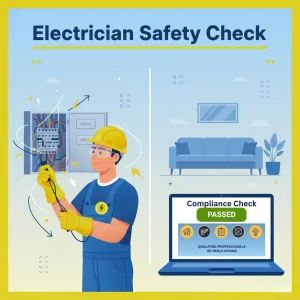
Landlords can find qualified electricians through several channels:![]() Professional associations like Alllandlordcertificates.co.uk
Professional associations like Alllandlordcertificates.co.uk![]() Online directories
Online directories![]() Recommendations from other property owners
Recommendations from other property owners
It is important to make sure the electrician:![]() Holds a valid license
Holds a valid license![]() Has insurance coverage
Has insurance coverage![]() Has experience with rental property inspections
Has experience with rental property inspections
Additional steps to verify reliability:![]() Check online reviews
Check online reviews![]() Ask for references
Ask for references
Required qualifications for conducting landlord electrical safety tests
Electricians doing landlord electrical safety checks need these things:
![]() A valid electrical license recognized in the local jurisdiction.
A valid electrical license recognized in the local jurisdiction.![]() Certification in electrical safety inspections or periodic inspection qualifications.
Certification in electrical safety inspections or periodic inspection qualifications.![]() Experience with residential or rental property electrical systems.
Experience with residential or rental property electrical systems.![]() Knowledge of current electrical safety regulations, including local landlord-tenant laws.
Knowledge of current electrical safety regulations, including local landlord-tenant laws.
Ensuring these qualifications helps landlords comply with legal requirements in London. They also keep tenants safe.
Choosing between independent electricians and inspection companies
Landlords can choose between independent electricians and inspection companies. Both have benefits depending on what you need.
Independent Electricians:![]() Costs less than companies.
Costs less than companies.![]() Can arrange visits at times that suit you.
Can arrange visits at times that suit you.![]() Give personal attention to each property.
Give personal attention to each property.
Inspection Companies:![]() Provide full testing and official certification.
Provide full testing and official certification.![]() Have several electricians ready, so scheduling is easier.
Have several electricians ready, so scheduling is easier.![]() Can offer extra services like maintenance checks and detailed reports.
Can offer extra services like maintenance checks and detailed reports.
The choice depends on how many properties you have, your budget, and the kind of support you want.
Case Study 1: Magenta Living (formerly Worrall Partnership Homes)
Source: GOV.UK
Context: Magenta Living reported that more than a third of its homes did not have a valid electrical safety inspection report. Many homes also needed electrical repairs that had not been done yet.
What went wrong: The company did not keep track of inspections well. They did not check that all safety tests happened and that repairs were completed on time.
Key lessons:![]() Planning inspections every five years is not enough if no one checks that they actually happen.
Planning inspections every five years is not enough if no one checks that they actually happen.![]() Keeping records and tracking repairs are just as important as doing the inspections.
Keeping records and tracking repairs are just as important as doing the inspections.![]() This shows why EICR reports, remedial work, and proper record-keeping are essential for safe rental homes.
This shows why EICR reports, remedial work, and proper record-keeping are essential for safe rental homes.
Case Study 2: Electrical faults found in England
Source: Electrical Safety First
Context: After new rules for rented homes came into effect in England, almost 7,000 electrical faults were found across 98 local councils.
What was found: Problems included live wires exposed, broken sockets, and wiring that overheats. Inspectors classified the faults as C1 (danger present) or C2 (potential danger).
Key lessons:![]() Regular inspections catch real dangers in homes.
Regular inspections catch real dangers in homes.![]() The fault classifications (C1, C2) are important and show the severity of issues.
The fault classifications (C1, C2) are important and show the severity of issues.![]() These cases highlight the need to schedule inspections and fix problems quickly.
These cases highlight the need to schedule inspections and fix problems quickly.
That’s why landlords must make electrical safety a top priority. Protect your tenants, prevent fires, and stay fully compliant with the latest regulations. Alllandlordcertificates.co.uk provides expert Electrical Installation Condition Reports (EICR), portable appliance testing, and complete electrical safety services for rental properties and HMOs. Don’t risk fines or dangerous faults.
Book your electrical safety check with Alllandlordcertificates.co.uk today and secure your property with confidence.
